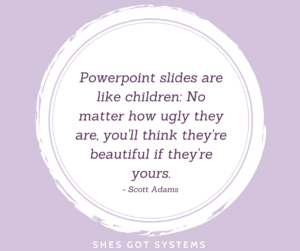When I was in college we had a pinnacle strategy class that was feared and dreaded by all in the business major. There was just one teacher, it was only available for seniors and students routinely went into mid-semester with a failing grade.
During one of the projects we were sorted into groups of 4 presenting before the class and my group went first.
What happened taught me my first lesson about empathy in business.
We thought we’d done a pretty good job, it had taken weeks of long sessions in the computer lab, researching online and practicing before we were ready to present. Wearing business suits and containing our nerves we presented and… the class basically fell asleep.
The (scary) teacher helped us break down what went wrong before class dismissed. He astutely asked the entire room, “how many of you are visual learners? You like to see images or videos to help you learn?”
Every student sitting in the class raised their hands.
He continued, “and how many of you prefer to learn by reading information?”
The four of us presenting raised our hands.
Ouch.
We hadn’t done a bad presentation, the information was correct and the bulletpoints were awesome.
But we’d forgotten to make our PowerPoint interesting because none of us liked to learn that way.
It’s something I run into as an entrepreneur all the time. Maybe your order pages are simple and streamlined. Here’s what you get, buy or leave. But your audience needs a little more encouragement and visual help, a testimonial would go a long way but you don’t read them so you’re not seeing that option as important.
Or perhaps you love video tutorials and so when someone sends you a survey or questionnaire, you send back a video answer. The person you’re responding to might find videos obnoxious, long and pointless, just write down your answer! they think as they are forced to watch the video.
As in our business class, so many things are not right or wrong, there are shades of preferences and we have to recognize that if we want to engage with more leads and clients.
Here’s one of the lessons I learned about rightness lately.
Let’s say you’re in a meeting and someone makes a statement you disagree with, do you:
a) Tell them they’re wrong
b) Offer a different opinion
Well, it all depends on context. If you’re in a meeting with the chief engineer of a nuclear power plant and they make a statement that is incorrect and following that plan means a nuclear meltdown, please tell that person they’re wrong (and of course back it up with evidence).
However, if you’re in a design meeting and your client wants to put a giant slider of photos on the top of their new website then you can give your opinion about the style and effectiveness, knowing that you’ll eventually need to follow the direction of the person paying for the project.
The problem comes when we fight over what we think is absolute truth when it comes to opinions.
Being able to see the other side of an issue, to step into the shoes of someone who thinks differently from you is the essence of empathy. It’s not “I feel sorry for you” – that’s sympathy – or “we’ll do it your way” – that’s being a doormat.
It takes practice but when you’re running a business try to understand how others are thinking and what they need. If it’s easy (like graphics on a powerpoint) then accommodate when you can. If it’s not easily done (like giving 10,000 people your personal email address to ask you questions at anytime) then understand where the request is coming from and answer with empathy.
I consider myself lucky that I started learning this lesson 12 (!) years ago in college and it’s something I continue to practice throughout my business.


 Never Train Your Employees Again
Never Train Your Employees Again Are you the bottleneck in your business?
Are you the bottleneck in your business? Does Business Productivity Matter?
Does Business Productivity Matter?